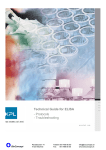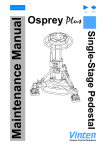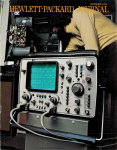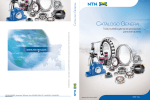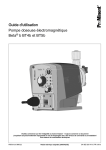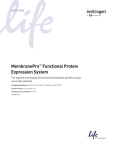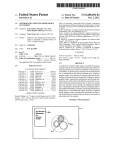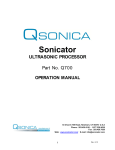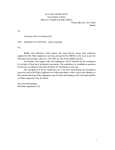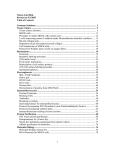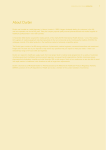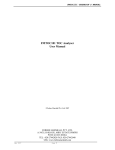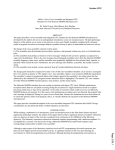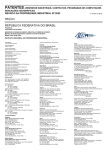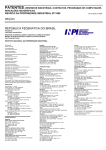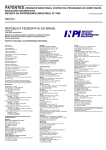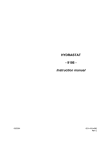Download RNAi Duplex
Transcript
US 20070213284Al (19) United States (12) Patent Application Publication (10) Pub. No.: US 2007/0213284 A1 (43) Pub. Date: Sohail et al. (54) METHOD OF SELECTING TARGETS FOR GENE SILENCING BY RNA INTERFERENCE (30) Foreign Application Priority Data May 28, 2002 (76) Inventors: Muhammad Sohail, Oxford (GB); (51) Correspondence Address: FOLEY & LARDNER LLP 111 HUNTINGTON AVENUE 26TH FLOOR BOSTON, MA 02199-7610 (US) (52) (57) (21) Appl. No.: 10/996,865 (GB) ....................................... .. 02123024 Publication Classi?cation Valentine Moya Macaulay, Oxford (GB) Sep. 13, 2007 Int. Cl. A61K 31/7105 A61K 31/713 C07H 21/02 C12N 15/64 (2006.01) (2006.01) (2006.01) (2006.01) US. Cl. ......................... .. 514/44; 435/91.4; 536/245 ABSTRACT The invention relates to the selection of target regions of Nov. 24, 2004 RNA transcripts for speci?c down-regulation of gene expression by RNA interference. Target regions of the Related US. Application Data transcript are identi?ed on the basis of hybridisation to (63) Continuation of application No. PCT/GB03/02307, reagents comprising double-stranded RNAs corresponding (22) Filed: scanning arrays of antisense oligonucleotides and siRNA ?led on May 28, 2003. to the target regions are then synthesised. RNAi Duplex IOnM IGF-I IGFlR-B \ Akt Ser 473 Total Akt Patent Application Publication Sep. 13, 2007 Sheet 2 0f 9 OmwaUOZwm mi. 0mm 9 H02 ‘% 0mmahNuQ2. unmy w . 0mm 8 H02 0mm9H02aw US 2007/0213284 A1 Patent Application Publication Sep. 13, 2007 Sheet 3 0f 9 US 2007/0213284 A1 W52 200 “51* —ir+ + 0 100 200 Gone (nM) 300 400 A301 ASOZ A803 A806 TSS ASO Patent Application Publication Sep. 13, 2007 Sheet 4 0f 9 US 2007/0213284 A1 Pro m F R 'é'iLipi Conc (nM) Agent cio'coco~ O Y 0 O 200200 200 200 0 A80 .scr O'O 20 200 HNAi B. Conc (nM) Agent 0 Cone (nM) 500 Agent 1 RNAi 50 RNAi 5 500 0 ‘ 50 lnv RNA OOC 20 200 O lnv RNA 0 Patent Application Publication Sep. 13, 2007 Sheet 5 0f 9 US 2007/0213284 A1 5:92805 “ER mm w N1 N2: x295 Patent Application Publication Sep. 13, 2007 Sheet 6 0f 9 US 2007/0213284 A1 rm 2. IUI 5:928 0 5 @Q - QQ h.wENrc>FwVN_ m m6 m. mic m md m6 m Patent Application Publication Sep. 13, 2007 Sheet 7 0f 9 E57&25 3E92 Q ,E v?5wms“ US 2007/0213284 A1 52v2 Patent Application Publication Sep. 13, 2007 Sheet 8 0f 9 US 2007/0213284 A1 2 Patent Application Publication Sep. 13, 2007 Sheet 9 0f 9 US 2007/0213284 A1 W56 IGF1R cDNA sequence bases 1-1000. SEO ID NO: 56 1 51 101 151 201 251 301 351 401 T‘I'TTTTTTTTTTTTGAGAAAGGGAATTTCATCCCAAATAAAAGGAALIQAA GTCTGGCTCCGGAGGAGGGTCCCCGACCTCGCTG‘I'GGGGGCTCCTGTTTC TCTCCGCCGCGC'I'CTCGCTCTGGCCGACGAGTGGAGAAA‘I‘CTGCGGGCCA GGCATCGACATCCGCAACGACTATCAGCAGCTGAAGCGCCTGGAGAACTG CACGGTGATCGAGGGCTACCTCCACATCCTGCTCATCTCCAAGGCCGAGG ACTACCGCAGCTACCGC'I‘TCCCCAAGCTCACGGTCATTAC'CGAGTACTTG CTGCTGTTCCGAGTGGCTGGCCTCGAGAGCCTCGGAGACCTC‘I'TCCCCAA CCTCACGG'I‘CATCCGCGGCTGGAAACTCTTCTACAACTACGCCCTGGTCA TCTTCGAGATGACCAATCTCAAGGATATTGGGCTTTACAACCTGAGGACA 451 ‘ TTACTCGGGGGGCCATCAGGATTGAGAAAAATGC‘TGACCTCTGTTACCTC s01 TCCACTGTGGACTGGTCCCTGATCCTGGATGCGGLGTQW s51 601 TG GGGGAATAAGCCCCCAAAGGAATGT TGGAGGAGAAGCCGATGTG GA C'CAC 651 701 751 TACCGCTGCTGGACQCAAACCGCTGCCAGAAAATGTGCCCAAGCACGTG TGG'GAAGCGGGCGTGCACCGAGAACAATGAGTGCTGCCACCCCGAGTGCC TGGGCAGCTGCAGCGCGCCTGACAACGACACGGCCTGTGTAGCTTGCCGC '1' CTGTGTCCAG CCA CAATGAGTACAAC 8'01 CACTACTAC'I‘ATGCCGGTGTCTGTGTGCCTGCCTGCCCGCCCAACACCTA s51 CAGGT'I‘TGAGGGCTGGCGCTGTGTGGACCGTGACTTCTGCGCCAACATCC 901 TCAGCGCCGAGAGCAGCGACTCCGAGGGGT'I'TGTGATCCACGACGGCGAG 951 ' TGCATGCAGGAGTGCCCCTCGGGCTTCATCCGCAACG'GCAGCCAGAGCAT _ Underlined are translation start site and region screened by array. Latter covers 150m representing bases 536-685 of human IGF 1R sequence. Sep. 13,2007 US 2007/0213284 A1 METHOD OF SELECTING TARGETS FOR GENE SILENCING BY RNA INTERFERENCE FIELD OF THE INVENTION [0001] The invention relates to the preparation of double stranded RNA reagents for use in the speci?c doWn-regu lation of gene expression by RNA interference by hybridi sation to scanning arrays of antisense oligonucleotides. BACKGROUND TO THE INVENTION [0002] RNA interference (RNAi) is a process of sequence speci?c gene silencing initiated by double-stranded RNA (dsRNA) that is homologous in sequence to a region of the silenced gene (Fire, A. Trends Genet. Vol. 15, 358-363, 1999; Sharp, P. A. Genes Dev. Vol. 15, 485-490, 2001). [0010] (c) identifying an oligonucleotide Within the array Which hybridiZes With the labelled transcripts; and [0011] (d) preparing an siRNA reagent comprising a double-stranded RNA of identical sequence to the oligo nucleotide identi?ed in step (c). [0012] As aforesaid, it is knoWn to use scanning arrays of antisense oligonucleotides in order to identify regions of a particular transcript to target for inhibition of gene expres sion using antisense oligonucleotides. HoWever, it Was sur prising to observe that sequences identi?ed using the scan ning array as being useful as antisense oligonucleotides may also mediate gene silencing by RNA interference because the mechanisms of action of antisense oligonucleotides and RNA interference are very different (see revieW by Brantl, S. Antisense-RNA regulation and RNA interference, Biochem Biophys Acta. Vol. 1575(1-3), 15-25, 2002). [0003] Elbashir et al. (Nature, 411, 494-498, 2001) have [0013] demonstrated effective RNAi-mediated gene silencing in mammalian cells using dsRNA fragments of 21 nucleotides in length (also termed small interfering RNAs or siRNAs). These short siRNAs demonstrate effective and speci?c gene silencing, Whilst avoiding the interferon-mediated non-spe ci?c reduction in gene expression Which has been observed With the use of dsRNAs greater than 30 bp in length (Stark G. R. et al., Ann Rev Biochem. 1998, 67: 227-264; Manche, L et al., Mol Cell Biol., 1992, 12: 5238-5248). Thus, siRNAs molecule that is capable of doWn-regulating expression of a target gene by RNA interference. The characteristics of represent promising candidate gene-speci?c therapeutic agents, providing an alternative to anti-sense oligonucle otides. The term “siRNA reagent” refers to a nucleic acid siRNA reagents are generally knoWn in the art. siRNA reagents generally comprise a region of double-stranded RNA, although as discussed beloW one or more bases in the double-stranded RNA may be replaced With DNA bases. The double-stranded RNA may be ?anked by short single stranded overhangs, as described beloW. [0014] Scanning oligonucleotide arrays comprising oligo nucleotides complementary to a target region of a mRNA transcript of the gene of interest may be synthesised using the methods Which are knoWn in the art and described, for [0004] One potential problem to be overcome in the development of siRNA agents for any given gene is the selection of an appropriate region of the gene to target in order to achieve effective gene-silencing by RNAi. [0005] In the ?eld of anti-sense oligonucleotide technol ogy suitable single-stranded antisense oligonucleotides for a given gene may be selected With the use of scanning arrays example by Southern E. M. et al., Nucleic Acids Res., 1994, 22(8): 1368-1373 and Sohail, M. and Southern, E. M. “Using oligonucleotide scanning arrays to ?nd effective antisense reagents”, Methods in Molecular Biology, vol. 170: DNA Arrays: Methods and Protocols, Ed I. B. Rampal, Humana Press Inc., TotoWa, N.J., the contents of Which documents are incorporated herein by reference. A detailed protocol for synthesis of scanning arrays is also given in the (Southern, E. M. et al., Nucleic Acids Res., 1994, 22(8): 1368-1373; Sohail, M. and Southern, E. M. “Using oligo accompanying examples. nucleotide scanning arrays to ?nd effective antisense reagents”, Methods in Molecular Biology, vol. 170: DNA [0015] Scanning arrays are a simple tool that alloW com binatorial synthesis of a large number of oligonucleotides on a solid platform (typically glass or polypropylene, see note 1 in accompanying examples) in a spatially addressable Arrays: Methods and Protocols, Ed I. B. Rampal, Humana Press Inc., TotoWa, N.J.; Sohail, M. et al., Nucleic Acids Res., 2001, 29(10): 2041-2051). fashion, and parallel measurement of the binding of all oligonucleotides complementary to the target mRNA. [0006] The present inventors have noW shoWn that the sequences selected for use in single-stranded antisense oli gonucleotides on basis of array screening can also be used [0016] The scanning arrays comprise sets of oligonucle as the basis of siRNA reagents that are effective in gene silencing by RNAi. DESCRIPTION OF THE INVENTION [0007] In accordance With a ?rst aspect of the invention there is provided a method of preparing an siRNA reagent for use in gene silencing of a target gene by RNA interfer ence, Which method comprises: otides of various lengths. A series of oligonucleotides, complementary to the target mRNA, is made by sequential coupling of nucleotides to a solid surface. The DNA syn thesis reagents are applied to a con?ned area on the surface of the solid support using a mask (see beloW). The mask is shifted along the surface after each round of coupling, resulting in a series of oligonucleotides each complementary to a region of the target sequence. [0017] The “gene of interest” may be essentially any gene for Which it is desired to develop an siRNA/RNAi reagent. [0009] (b) hybridising to the array labelled transcripts of The method of the invention is of general utility, thus the precise nature of this gene (and the mRNAs transcribed therefrom) is not material to the invention. The “target region” may be a sub-fragment of the gene of interest Which it is desired to test in order to identify region(s) Which may the target gene; potentially be useful targets for gene silencing by RNA [0008] (a) preparing a scanning array of antisense oligo nucleotides spanning a region of a transcript of the target gene; Sep. 13,2007 US 2007/0213284 A1 interference. The “target region” may be an arbitrarily chosen sub-fragment of the gene of interest or may have been selected on the basis of an assay for potentially suitability as an RNAi target. For example, the “target region” may be one Which is relatively accessible in the mRNA transcript because of a relative lack of secondary structure. Regions of mRNA transcripts Which are poten tially accessible for gene silencing may be identi?ed by RNaseH mapping (see Sohail et al., Nucleic Acids Res., 2001, 29(10): 2041-2051). [0018] The scanning arrays Will generally containing all complements of the selected target sequence up to a maxi mum length determined by the siZe of the template and template displacement used in the synthesis of the scanning array (Southern et al. 1994, ibid). Typically, the maximum length of the oligonucleotides in the array Will be around 18-20 nt, but this may be varied if required. The short dsRNAs (siRNAs) used for RNA interference are typically 21-23 bp in length, hence it Would be appropriate to include similar length sequences in the array. [0019] The scanning arrays are hybridised With a probe Which is a transcript of the gene of interest labelled With a revealing label, Which may be essentially any type of revealing label Which permits visualisation and quantitation of the hybridisation intensity. Radiolabels are particularly preferred. Suitable labelled RNA probes may be conve niently synthesised using standard techniques knoWn in the art (see accompanying examples). particularly preferred embodiment the dsRNA may contain 3' overhanging nucleotides, preferably 3' overhanging thy midines (dTdT) or uridines (UU). [0022] siRNA reagents may be formed of RNA/DNA chimeras. These chimeras include, for example, the siRNA reagents comprising a double-stranded RNA With 3' over hangs of DNA bases (e.g. dTdT), as discussed above, and also siRNA reagents comprising a double-stranded “RNA” in Which one or more of the RNA bases, or even an entire strand, are replaced With DNA bases. [0023] In a further embodiment rather than being formed of tWo separate RNA strands annealed together, the si RNA reagent may comprise a dsRNA having a foldback stem-loop or hairpin structure, Wherein the tWo strands of the dsRNA are covalently linked. RNAs having this structure are typical if the dsRNA is synthesised by expression in vivo or by in vitro transcription. The precise nature and sequence of the “loop” linking the tWo RNA strands is generally not material to the invention, except that it should not impair the ability of the double-stranded part of the molecule to mediate RNAi. [0024] The double-stranded RNA Will preferably com prise 20-27, or 20-24, consecutive nucleotides of the target mRNA sequence, since duplexes of this length are particu larly effective in RNAi. [0025] Double-stranded RNAs may be synthesised in vitro using chemical or enzymatic RNA synthesis techniques Well knoWn in the art. In one approach the tWo separate RNA [0020] Typically the hybridisation Will be carried out at a temperature in the range 20-370 C. Hybridisation at 370 C. is particularly preferred, since oligonucleotides Which hybri dise at this temperature are more likely to be effective in vivo. The compositions of standard hybridisation buffers Which are preferred for use With the arrays are given in the accompanying examples. strands may be synthesised separately and then annealed to form double-strands. [0026] In a further embodiment, double-stranded RNAs may be synthesised by intracellular expression from a suit able expression vector. Thus, the invention further provides a method of preparing an expression vector capable of expressing an siRNA reagent for use in gene silencing of a [0021] Oligonucleotides Which hybridise to the array are identi?ed and double-stranded RNA reagents (also referred target gene by RNA interference, Which method comprises: to herein as RNAi reagents or siRNAs) having identical sequence are synthesised. The inventors have demonstrated nucleotides spanning a region of a transcript of the target [0027] (a) preparing a scanning array of antisense oligo by experiment that hybridisation to the scanning array is directly predictive of effectiveness in RNA interference. In gene; this context “identical sequence” is not intended to be the target gene; interpreted literally as requiring 100% sequence identity. The sequence of the dsRNA may differ slightly from the antisense oligonucleotide (ASO) sequence. For example the length of the dsRNA may be longer or shorter by several nt to optimise performance of the dsRNA. The RNA duplex Will preferably be less than 30 bp in length, since duplexes of greater than 30 bp may induce non-speci?c interferon mediated effects When introduced into cells in vivo. RNA [0028] (b) hybridising to the array labelled transcripts of [0029] (c) identifying an oligonucleotide Within the array Which hybridiZes With the labelled transcripts; and [0030] (d) preparing an expression vector capable of expressing an siRNA reagent comprising a double-stranded RNA of identical sequence to the oligonucleotide identi?ed in step (c). duplexes of 20-27 bp, and typically 20-24 bp, in length are [0031] A number of expression vector systems for in vivo particularly suitable as RNAi reagents. If the dsRNA is made longer than the ASO then the extra sequence may corre spond to the “native” sequence of the mRNA. The dsRNA reagents (also referred to as small interfering RNAs, or siRNAs) are knoWn in the art. Generally, siRNAs are may contain one or more substitute bases in order to expression of short double-stranded RNAs for use as RNAi expressed as stem-loops, Which may be rapidly processed Within the cell to produce the “free” siRNA (see revieW by optimise performance in RNAi. Substitution of even a single nucleotide may have a profound effect on activity of the RNAi duplex. The dsRNA may further contain non-natural bases or non-natural backbone linkages, for example to enhance stability in vivo or enhance resistance to degrada tion by nucleases. The dsRNA may also include single Vector systems for expression of siRNAs are often based on RNA Pol III promoters, since these are particularly suited to accurate expression of very short RNA sequences. Suitable vector systems are described in Brummelkamp, T. R. et al., stranded overhangs at one or both ends of the duplex. In a Science, Vol. 296, 550-553, 2002; Lee, N. S. et al., Nature Tuschl, Nature Biotechnology, Vol. 20(5), 446-448, 2002). Sep. 13,2007 US 2007/0213284 A1 Biotechnology, Vol. 20, 500-505, 2002; Miyagashi, M & Taira, K. Nature Biotechnology, Vol. 20, 497-500, 2002; Paul, C. P. et al., Nature Biotechnology, Vol. 20, 505-508, 2002, the contents of Which are incorporated herein by reference. [0032] In a further aspect the invention provides a method of preparing a pharmaceutical composition comprising an siRNA reagent capable of mediating gene silencing of a target gene by RNA interference, Which method comprises: [0033] preparing an siRNA reagent capable of mediating gene silencing of a target gene by RNA interference accord ing to the method described above and formulating the [0039] FIG. 1 shoWs representative plots of hybridisation intensity across the array for (a) l5mers and (b) l8mers probed With labelled IGFlR mRNA. [0040] FIG. 2 illustrates the effect of ASCs and RNAi on IGFlR levels in MDA-23l human breast cancer cells. The cells Were transfected at 30-40% con?uence With phospho rothioate ASOs complexed With the lipid Cytofectin (Glen GSV). After 48 hr the cells Were lysed and equivalent amounts of soluble protein Were separated by SDS-PAGE and immunoblotted for IGFlR and [3-tubulin (loading con trol). The intensity of the autoradiographic bands Was quan ti?ed by densitometry, and IGFlR levels Were corrected for ing the siRNA reagent and one or more diluents, excipients loading differences. The results are shoWn as % IGFlR level of that in cells transfected With the same concentration of an appropriate control. This Was a scrambled control oligo or carriers. nucleotide for ASOs, and an inverted RNA duplex for RNAi. [0034] siRNA reagents may be formulated into pharma ceutical compositions comprising a therapeutically effective [0041] FIG. 3 illustrates the effect of ASOs and RNAi on IGF l R and IR levels in MDA-23l human breast cancer cells and ME melanoma cells. Cells Were transfected using either siRNA reagent into a pharmaceutical composition compris amount of the siRNA nucleic acid in combination With any standard physiologically and/or pharmaceutically accept Cytofectin (C) or Oligofectamine (O; Gibco BRL). After 48 able carriers knoWn in the art. “Pharmaceutically accept hr the cells Were lysed and IGFlR and IR levels Were able” means a non-toxic material Which does not interfere determined by immunoblotting. With the activity of the pharmaceutically active ingredients in the composition. “Physiologically acceptable” refers to a non-toxic material that is compatible With a biological system such as a cell, tissue or organism. Physiologically and pharmaceutically acceptable carriers may include dilu ents, ?llers, salts, buffers, stabiliZers, solubiliZers etc. [0035] For delivery into cells in vivo siRNAs may be formulated With lipid-based carriers including, for example, oil-in Water emulsions, micelles, and liposomes. Liposomes a) MDA-23l breast cancer cells transfected With ASO 2 (or scrambled control, Scr) or RNAi or inverted RNA duplex control (InvRNA) at 20 or 200 nM. b) MDA-23l cells Were transfected With Oligofectamine and RNAi or Inverted control (InvRNA) at 01-10 nM. c) ME melanoma cells Were transfected With Oligofectamine and RNAi or Inv control duplex at 5-500 nM. are the most preferred carriers, and there use is Well knoWn in the art. Liposomes are commercially available from Gibco BRL, for example, as LIPOFECTINTM and OLIGO FECTAMINETM, Which are formed of cationic lipids. Meth ods for making liposomes are Well knoWn in the art and have [0042] FIG. 4 illustrates the effects of various RNAi duplexes in MDA-23l breast cancer cells. MDA-23l cells Were transfected With oligofectamine and 2lmer RNA duplexes at 0.5, 5 and 50 nm. After 48 hr IGFlR expression been described in many publications. Liposomes may be targeted to a particular tissue by coupling the liposome to a particular tissue by coupling the liposome to a speci?c graphical illustration, results are presented as % IGFlR level ligand, such as a monoclonal antibody, sugar, glycolipid or Was analysed by immunoblotting (panel (a)). Panel (b) is a of that in cells transfected With the same concentration of an inverted control RNAi. protein. [0043] FIG. 5 illustrates the activity of RNAi duplexes of [0036] Liposomes may also be used to deliver vectors encoding siRNAs. In the ?eld of human gene therapy it is Well knoWn to deliver expression vectors, such as plasmids, IGFlR expression at 0.5 and 5 nM; panel (b) is a graphical illustration shoWing the effect of RNAis of varying length, via nucleic acid-liposome complexes. [0037] For use in human therapy, pharmaceutical compo sitions including the siRNAs of the invention Will be admin istered to a patient in need of treatment in a “therapeutically acceptable amount”. A therapeutically acceptable amount is an amount of a pharmaceutical preparation that alone, or together With further doses, produces the desired response in the condition being treated. The precise amount of the 18, 21 or 24 nt in MDA-23l breast cancer cells. Panel (a) is an immunoblot shoWing the effect of various RNAis on results are presented as % IGFlR level of that in cells transfected With the same concentration of an Inv2 control RNAi. [0044] FIG. 6 illustrates the effect of RNAi duplexes on Akt phosphorylation in ME melanoma cells. ME cells Were transfected With 100 nM RNA duplexes. After 48 hr the monolayers Were disaggregated and half of each culture Was treated With 10 nM IGF-l for 30 min. The cells Were lysed composition administered Will, hoWever, generally be deter and lysates Were analysed by immunoblotting for IGFlR, mined by a medical practitioner, based on the circumstances pertaining to the disorder to be treated, such as the severity phospho-Ser473-Akt and total Akt. of the symptoms, the composition to be administered, the age, Weight, and response of the individual patient and the chosen route of administration. [0038] The invention Will be further understood With reference to the folloWing experimental protocols, together With the accompanying Figures, in Which: [0045] FIG. 7 illustrates groWth in vivo in C57BL mice of B16 melanoma cells transfected With RNA duplexes. B16 melanoma cells Were transfected With 200 nM duplexes (RNA22=R2,22Inv=Inv2) or oligofectamine alone (OF) for three consecutive days. On the 4th day cells Were injected into the ?anks of C57BL mice, using 2.5><l05 cells/mouse, using groups of 5 mice. Tumours Were measured in 2 Sep. 13,2007 US 2007/0213284 A1 dimensions every 2-3 days. Tumour volumes Were calcu lated as n(a><b2)/6 Where a is the larger and b the smaller dimension. [0046] FIG. 8 shows the complete cDNA sequence for human IGFlR. The region evaluated using the scanning array is underlined. 9. Ether (AnalaR: Merck). 10. Water bath at 800 C. Making Reaction Masks 1. Stainless steel or aluminium square metal piece or PTFE (Te?on). Dimensions of the Workpiece may vary according to the siZe of the mask. EXAMPLE IiSYNTHESIS OF A SCANNING ARRAY [0047] In the folloWing protocol references to Figures and Tables from “Sohail and Southern” refer to Sohail, M. and 2. A centre lathe or a horiZontal milling machine. 3. A drilling machine. Southern, E. M. “Using oligonucleotide scanning arrays to 4. Abrasive paper from ~P600 to P1200 (3M Inc., USA) and polishing grade crocus paper (I. G. Naylor & Co. Ltd., ?nd effective antisense reagents”, Methods in Molecular Biology, vol. 170: DNA Arrays: Methods and Protocols, Ed I. B. Rampal, Humana Press Inc., TotoWa, N]. Woodley, Stockport, Manchester, England). Making Scanning Arrays [0048] Using a diamond-shaped or a circular reaction mask (Sohail and Southern, FIG. 1), it is possible to create arrays comprising sets of oligonucleotides of all lengths from monomers up to a maximum in a single series of couplings. The maximum length of oligonucleotides syn thesised depends upon the ratio of the diagonal (for a diamond-shaped mask) or diameter (for a circular mask) of the mask to the displacement at each coupling step. For example, a diamond-shaped mask of 40 mm diagonal Will produce 10-mers, 16-mers, or 20-mers using step siZes of 4 mm, 2.5 mm, or 2 mm, respectively. A diamond-shaped template creates a series of small diamond-shaped cells. The longest oligonucleotides are found along the centre line and 1. Solid support (derivatised glass or aminated polypropy lene (Beckman Coulter, Inc., USA)). 2. DNA synthesiser (ABI). 3. A reaction mask of desired shape and siZe and assembly frame (see Sohail and Southern FIG. 4 for the assembly). 4. DNA synthesis reagents: standard dA, dG, dC and T phosphoramidites, oxidiZing agent, acetonitrile, activator solution, deblock solution (all from Cruachem). 5. Reverse phosphoramidites bought from Glen Research Deprotection of Arrays the monomers are located at the edge (Sohail and Southern, [0050] FIG. 1). A circular template creates cells that differ in shape: along the centre line, they are lenticular, but off this line, they form a four-cornered “spearhead” that diminishes in shoWn in Sohail and Southern FIG. 5. The assembly consists of a high density polyethylene (HDPE) chamber, 4 mm thick silicon rubber gasket and a stainless steel plate of the dimensions of the HDPE chamber, and stainless steel M8 siZe toWards the edge. The arrays as synthesised are sym metrical above and beloW the centre line of the template and each oligonucleotide is represented tWice alloWing for dupli 1.Assembly for constructing deprotection bomb as nuts and bolts. cate hybridisation measurements. 2. 30% ammonia solution (AnalaR: Merck). [0049] 3. Water bath at 55° C. For each length of oligonucleotides s, there are N—s+1 s-mers covering a total length of N bases. For example, if a 150 nt long sequence is covered in a 150 step synthesis, there Will be 150 monomers and 131 20-mers. The last 20 positions in the sequence Will be represented by shorter oligonucleotides only; in this case, from 19-mer to monomer. Therefore, for making 200 20-mers, an additional 19 nt synthesis steps need to be added at the end, i.e., total coupling steps N+s—l. Materials In Vitro Transcription 1. Template DNA (at ~1 mg/mL). 2. T7 or SP6 RNA polymerase, transcription buffer (5>< transcription buffer is, 200 mM Tris-HCl pH 7.9, 30 mM MgCl2, 10 mM spermidine, 50 mM NaCl), recombinant RNAsin®, 100 mM DTT and nuclease-free distilled Water (Promega). 3. [ot-32P] UTP (3000 Ci/mmol) or [ot-33P] UTP (2500 Derivatisation of Glass Ci/mmol) (Amersham). 1. Glass cylinder and apparatus shoWn in Sohail and South 4. rNTPs (Pharmacia): ATP, GTP, CTP stored as 10 mM solution, and UTP as 250 mM solution in nuclease-free distilled Water. Store all reagents at —200 C. ern, FIG. 3. 2. Glass sheets of required dimension (3 mm thick: Pilking ton, UK). 3. 3-Glycidoxypropyl trimethyoxysilane (98% v/v: Aldrich). 4. Di-isopropylethylamine (99.5% v/v: Aldrich). 5. Xylene (AnalaR: Merck). 6. Hexaethylene glycol (97% v/v: Aldrich). Quantitation of Transcripts 1. Scintillation counter (e.g., Beckman LS 1710). 2. Scintillation Vials and Scintillation Fluid (Amersham). [0051] Hybridisation, Imaging and Analysis 7. Sulfuric acid (AnalaR: Merck). 1. Hybridisation bulfer (1M NaCl, 10 mM Tris-HCl pH 7.4, 1 mM EDTA, 0.01% SDS (W/v)) (see Note. 2). 8. Ethanol (AnalaR: Merck). 2. 50-100 fmol radiolabelled transcript. Sep. 13,2007 US 2007/0213284 A1 3. A glass plate of the size of the array When using an array made on glass, a moist chamber (a large plastic or glass lidded box containing Wetted paper towels) and an incubator set to the desired temperature. 4. A hybridisation tube and oven used in standard Southern hybridisation (e.g., Techne) When using an array made on polypropylene. 5. Esco rubber tubing of OD 1 mm (Sterlin) for use in Section 3.8. 5. Finish the sealing edge by polishing ?at With successively ?ner grades of Wetted abrasive paper (from ~P600 to P1200) and ?nally With a polishing grade crocus paper. [0053] 6. Drill holes of 1.08 mm diameter for reagent inlet and outlet, respectively, at the bottom and the top of the reaction chamber (in the comers of the diamonds). Inlet and outlet connections to the DNA synthesiser are made using standard 19SWG syringe needles (1.1 mm diameter) With chamfered ends ground off and de-burred (see Note 5). Fabrication of Arrays 6. Storage phosphor screen (Fuji or Kodak). 7. PhosphorImager or STORM (Molecular Dynamics). 8. A SUN Solaris Work station for image analysis and the computer software xvseq (L. Wand and J. K. Elder, unpub lished) (available by anonymous ftp at ftp://bioch.ox.ac.uk/ [0054] 1. Cut glass or polypropylene to the correct siZe. The process of making an array is the same When using either glass or polypropylene. Polypropylene has to be mounted on a glass plate, e.g., 3 mm thick soda glass (see Note 6). The total area covered by an array for N bases using pub/xvseq.tar.gZ). a mask of diagonal or diameter D m and step siZe 1 mm is N><1+D mm. 2-3 mm are added to margins to alloW easy Stripping of Arrays manipulations. 1. Stripping solution (100 mM sodium carbonate/bicarbon ate bulfer pH 10, 0.01% SDS (W/v)) (see Note 3). 2. Fix the assembly (Sohail and Southern FIG. 4) to the front 2. Geiger-Muller counter (Mini-Instruments Ltd.). of a DNA synthesiser and connect its inlet and outlet to the synthesiser’s reagent supply. 3. Program the DNA synthesiser With an appropriate syn Methods thesis cycle. A slightly modi?ed cycle is used, for example, Derivatisation of Glass the one given in Table 1 (Sohail and Southern). Also check all the reagent bottles. [0052] 1. Prepare a mixture of di-isopropylethylamine, glycidoxypropyl trimethoxysilane and xylene (1:178:69, 4. Enter the sequence (antisense strand) in 5' to 3' direction. v/v/v) in a glass cylinder and completely immerse the glass [0055] plates in the mixture. Incubate as shoWn in Sohail and Southern FIG. 3 at 800 C. for 9 h. the support by placing it against the mask on the assembly in the desired starting position (see Sohail and Southern FIG. 2. Remove the plates, alloW them to cool to room tempera ture, and Wash With ethanol and then With ether by squirting the liquid from a Wash bottle. 3. Incubate the plates in hexaethylene glycol containing a catalytic amount of sulfuric acid (~25 mL/L) at 800 C. for 10 h, With stirring. 5. Mark the ?rst footprint of the reaction mask on 6). A knife is used to make notches in polypropylene. A diamond scriber can be used to mark glass. [0056] 6. Tighten the plate against the mask With the pressure clamp to produce a seal (Sohail and Southern FIG. 4b). Suf?cient pressure is applied to stop leakage (~500-800 NeWton force) but not enough to create indentations in the polypropylene surface Which can lead to leakage of reagent from the mask during subsequent synthesis steps. 4. Remove the plates, alloW them to cool to room tempera ture, and Wash With ethanol and ether. Air dry and store at —200 C. 7. Start the DNA synthesiser to go through the pre-pro Machining of Masks ?rst condensation on the substrate is of base at the 3' end of the sequence. 1. Both stainless steel or aluminium can be used to make diamond-shaped and circular reaction masks. Circular masks are made using a centre lathe and diamond shaped masks using a horiZontal milling machine (see Note 4). 2. To make a diamond shaped mask from metal, hold the Work piece at an angle of 45° to the axis of the bed of the milling machine (the diagonal of the diamond running parallel to the axis of the bed. 3. Machine the cavity to the required depth (generally betWeen 0.5-0.75 mm) to create a reaction chamber. Machine the outer lands to a depth of approximately 0.5 mm grammed cycle to couple the appropriate nucleotide. The 8. After completion of the step during the interrupt (see Sohail and Southern Table 1 and Note 7), slacken the pressure clamp and move the plate one increment (Sohail and Southern FIG. 4b). 9. Tighten the pressure clamp and start the synthesiser for the next nucleotide in the sequence. Continue the process until the full sequence length is synthesised (see Note 8). Deprotection of Arrays 1. Place the glass or polypropylene array(s) into the HDPE chamber (see Note 9) and add 30% ammonia into the chamber to cover the array(s) completely. to form the sealing edge (0.3-0.5 mm Wide) (Sohail and Southern FIG. 4). 2. Place the silicon rubber gasket around the rim of the chamber and the stainless steel plate on top of the gasket. 4. Using the smallest possible diameter cutter (~1.5 mm), 3. Place bolts through the metal plate, the gasket and the HDPE chamber, and tighten. radius the internal corners of the reaction chamber. Sep. 13,2007 US 2007/0213284 A1 4. Incubate in a Water bath at 55° C. for 12-18 h in a fume hood. Hybridisation to Arrays Made on Polypropylene 1. Place the array in the hybridisation tube, coiling it in a 5. Cool the assembly to 40 C. before opening. The arrays are spiral. ready to be used in hybridisation at this stage. 2. Dilute the radiolabelled transcript in an appropriate vol ume (10-20 mL depending upon the siZe of the array and the Preparing and Quantifying Radiolabelled Transcripts [0057] 1. Set an in vitro transcription reaction (20 pL) by adding the following components to a microfuge tube at room temperature. hybridisation tube) of hybridisation buffer. The mix should cover the array along the length of the tube. 3. Place items 1 and 2 in the oven at desired temperature for 30 min. Also put approximately 100 mL of the hybridisation buffer in the oven: this is to be used to Wash the array at the 100 mM DTT end of hybridisation. 4. Pour the hybridisation mix into the tube containing the RNAsin TM array and hybridise for 3-4 h. 5x transcription buffer 10 mM ATP, GTP, and CTP 250 mM UTP Template DNA (see Note 10) 5. Remove the hybridisation mix. Brie?y Wash the array With the hybridisation buffer from Step 3, air dry, cover With cling ?lm and expose to a storage phosphor screen for 16-20 T7 or SP6 RNA polymerase Total Volume Mix and incubate at 370 C. for 1 h. MN h (see Note 12). 6. Scan the screen on PhosphorImager or STORM and analyse the image using xvseq (see beloW). 2. Remove 1 ML for quantitation (see beloW). Hybridisation to Arrays Made on Glass 3. Remove unincorporated label by Sephadex® G25 column 1. Clean the non-array glass plate With acetone and ethanol to ensure it is grease-free and siliconise it by treatment With chromatography (see Note 11). 4. Save 1 ML of the puri?ed transcript for quantitation (see beloW). dimethyl dichlorosilane solution and place it in lidded box. Also place moist paper toWel in the box. 5. Check the integrity of the transcript by denaturing poly 2. Dilute the radiolabelled transcript in an appropriate vol ume of the hybridisation buffer (for example, for an array of acrylamide gel electrophoresis (10). 250 mm><50 m use 500-750 uL). 6. Add 10 ML of the scintillation ?uid to the samples saved in Steps 2 and 4. for 30 min. Also put approximately 100 mL of the hybridi 7. Mix by vortexing and count the samples in a scintillation at the end of hybridisation. counter for 1 min. 3. Place items 1 and 2 in an incubator at desired temperature sation buffer in the oven: this is to be used to Wash the array 4. Using a micropipette, pipette the hybridisation mix in a 8. Calculate the per cent-incorporation: line evenly along the length of the non-array glass plate, avoiding formation of air bubbles. , , incorporated cpm X 100 % mcorporatlon: — total cpm 9. Calculate the amount of RNA made: 20 pCi Amount of [a — 32P]UTP : 5. Starting at one end, carefully place the scanning array (face doWn) on top of the hybridisation mix. The mix Will spread out and form a thin ?lm betWeen the tWo plates. Incubate for 3-4 h. 6. Separate the plates from each other and Wash the array plate With hybridisation buffer to remove unbound mix. Drain the plate, air dry, cover With cling ?lm and expose to a storage phosphor screen for 16-20 h. i = 6.6><10’3 nmol 3000 p Ci/nmol Amount of cold UTP: 1 p_L><250 pM : 0.250 nmol Total UTP : 6.6 X1073 + 0.25 = 0.256 nmol 7. Scan the screen on PhosphorImager or STORM and analyse the image using xvseq (see beloW). Alternative Hybridisation Protocol for Glass or Polypropy lene 1. Assemble With clips the array plate (or polypropylene For a reaction With 50% incorporation, the amount of UTP incorporated =0.256 nmol+2=0.128 nmol Supposing equal incorporation of all four nucleotides, total nucleotides incorporated =0.128 nmol><4=0.512 nmol Amount of full-length transcript =0.512+ total length of transcript array pasted With PhotoMountTM on a glass plate) and the non-array plate, using rubber tubing as spacers on tWo sides. 2. Dilute the Radiolabelled Transcript in approximately 5-10 mL of hybridisation buffer. 3. FolloW Step 3, Protocol 3.7. 4. Inject the hybridisation mix into the space betWeen the tWo plates With a needle and syringe. 5. Incubate the assembly in horiZontal position at desired temperature. Sep. 13,2007 US 2007/0213284 A1 6. FolloW Steps 6 and 7, Protocol 3.7. Image Analysis [0058] The hybridisation images are analysed using xvseq (see Sohail and Southern FIG. 7). This program reads and displays images generated by a PhosphorImager or STORM and can also perform standard image manipulation such as scaling, clipping and rotation. Although visual inspection of an image reveals the results generally, computer-aided analysis is needed to obtain quantitative information about hybridisation intensities and the oligonucleotide sequences that generated them. xvseq calculates and displays inte grated intensities of the array oligonucleotides, each of Which corresponds to an image cell formed by intersection (1994) Anal. Biochem. 217, 306-310.) that also alloW syn thesis to oligonucleotides using standard CE nucleotide phosphoramidites. [0061] For the array fabrication method described here, it is important that a tight seal is formed betWeen the substrate material and the reaction mask. Metals form tight seal With polypropylene but not With glass. PTFE seals Well against both glass and polypropylene. 2. 1M NaCl is used routinely. Alternative buffers are: (i) 1 M NaCl, 5-10 mM MgCl2, 10 mM Tris-HCl pH 7.4, 1 mM EDTA, 0.01% SDS (W/v), and (ii) 150 mM NaCl, 10 mM MgCl2, 10 mM Tris-HCl pH 7.4, 1 mM EDTA, 0.01% SDS (W/v). of overlapping array templates. 3. Addition of more than 0.01% SDS can damage arrays. [0059] The user can specify the template siZe, shape and [0062] 4. Circular masks can also be made from PTFE (Te?on). Diamond-shaped masks are more dif?cult to make location, step siZe betWeen successive templates, as Well as the sequence that Was used to make the array. The template grid is superimposed on the image and the template param eters are adjusted interactively to achieve correct and accu rate registration of the grid With the hybridisation pattern. It can be dif?cult to achieve precise registration by reference to the hybridisation pattern alone, especially, if the signals at either edge of the array are Weak or undetectable. Avoid placing the template grid so that it appears to be registered but is in fact misaligned by one or more template steps. Registration can be aided by the use of ?xed reference points on an array such as those shoWn in Sohail and Southern FIG. 6. Stripping of Arrays 1. The arrays can be used several times. To strip, heat an appropriate volume of the stripping solution to 90° C. in a With PTFE by the machining process but can be made by pressure moulding in a hydraulic press (~150 ton force) using a pre-machined die. [0063] 5. Holes should be made as close as reasonably possible to the sealing edge Without damaging it. Care must be taken to de-burr fully the holes at the point of entry into the reaction chamber. For PTFE masks the holes should be 1.0 mm diameter Which make virtually 100% leak-tight seal. In the case of metal masks, the 0.02 mm interface indicated above also provides a leak-tight seal Without the use of any additional sealer. Care must be taken not to insert the end of the syringe needle into the reaction chamber void. [0064] 6. Unlike glass, polypropylene is not rigid and thus needs to be mounted on a solid, ?at surface for its precise glass beaker. movement against the reaction mask during synthesis. Even mounting of polypropylene on glass is important to produce 2. Immerse the array in the hot stripping solution and stir for 1-2 min. a good seal betWeen the sealing edge of the reaction mask and the polypropylene surface. Glass used must be clean and free from dust particles because they can cause bulging of 3. Remove the array and monitor With a Geiger counter to con?rm that most of the radiolabel has been removed. Repeat steps 1-2 if radioactivity on the surface of the array is still detectable. 4. AlloW the array to cool doWn to room temperature and Wash it thoroughly With nuclease-free distilled Water, 70% (v/v) ethanol and ?nally With absolute ethanol. 5. Air dry and store the array at —200 C. until future use. the polypropylene Which can hinder the formation of a proper seal. A very thin layer of PhotoMountTM (3M Inc, USA) Which can be used to paste polypropylene to glass, should be sprayed on glass and not polypropylene. [0065] 7. At the start of each synthesis cycle, an interrupt step can be introduced to halt the process at the ?rst step of the next nucleotide condensation cycle to alloW the operator to move the plate and restart the program. Alternatively, a long Wait step at the beginning of the program can be introduced (see Sohail and Southern Table 1) if the operator Notes [0060] 1. The choice of array substrate material and does not Wish to use the interrupt step. The operator is also advised to consult the user’s manual for the DNA synthe attachment chemistry is important for making high quality s1ser. arrays. A ?at, impermeable surface is required for in situ [0066] 8. With the use of standard phosphoramidites in the synthesis, the oligonucleotides are attached to the solid support at their 3' ends. Reverse phosphoramidites can be synthesis of arrays. Glass has a number of favourable qualities, including its Wide availability, smooth surface, transparency, chemical stability and compatibility With the use of both radiolabelled or ?uorescence labelled nucleic acids targets. Glass is chemically derivatised as described in the methods section to produce a hexaethylene glycol linker Which has a terminal ‘OH group that alloWs condensation of nucleotide phosphoramidites (Maskos, U., and Southern, E. M. (1992) Nucleic Acids Res. 20, 1679-1684.). Similarly, polypropylene also has favourable physical and chemical properties. Polypropylene is aminated to produce amine groups (Matson, R. S., Rampal, J. B., and Coassin, P. J. used to make oligonucleotides that are attached at their 5' ends. [0067] Iodine is used as an oxidising agent. At loWer temperatures it Will take longer to reach the top of the reaction cell. Iodine can also be replaced With sulfurising agent (Cruachem) to make arrays of phosphorothioate oli gonucleotides. 9. When using the standard phosphoramidites, the exocyclic amines of the bases are protected chemically to prevent side Sep. 13,2007 US 2007/0213284 A1 reactions during synthesis. These protecting groups need to be removed from the coupled bases before hybridisation. [0068] Before deprotection, detach the polypropylene arrays from glass by peeling from one end. PhotoMount can be removed With ethanol, acetone or dichloromethane. [0069] 10. An internally radiolabelled RNA is used as target to hybridise to a scanning array Which is generated by in vitro transcription, carried out in the presence of [(x-32P] approximately 100 bp of polylinker sequence betWeen the T7 promoter and the start of the IGFlR sequence. It Was thought that this extraneous vector-derived sequence might in?uence folding of the transcript. Therefore this region Was shortened by restriction digest using Not1, ?lling in With KlenoW enZyme, digestion With EcoRV and re-ligating to make construct 2 (1.6 kbA55). Both constructs Were lin earised at the 3' end of the IGFlR insert using Asp718, to UTP or [(X-33P] UTP (or [(x-32P] CTP) using an appropriate DNA template. A plasmid containing the desired DNA make templates for in vitro transcription. End-labelled tran fragment under the transcriptional control of a T7 or SP6 promoter (such as pGEM: Promega) can be used as tem generated using T7 RNA polymerase and y-32P-GTP (Amer sham Pharmacia). plate. The plasmid is linearised With an appropriate restric tion endonuclease to produce transcripts of de?ned length Results scripts 1 (1.6 kb) and 2 (1.6 kbA55) (see FIG. 1) Were Without contaminating vector sequence. Alternatively, a template With T7 or SP6 RNA promoter can also be gener [0076] Representative plots of hybridisation intensity ated using the polymerase chain reaction: primers are used to amplify the required fragment from a plasmid, genomic across the array for 15mers and 18mers probed With labelled IGFlR mRNA are shoWn in FIG. 1. The plots are annotated DNA or cDNA, such that the sense primer has a T7 or SP6 to shoW the position of selected individual oligonucleotide promoter leader sequence (Sohail and Southern Table 2) sequences. In each case the sequence given corresponds to added at the 5' end. the sense strand of the IGFlR mRNA. [0070] 11. Sephadex® G25 columns are available from several commercial suppliers including Promega and Phar macia. Spin columns made in-house, as described in (Sam brook, 1., Fritsch, E. E, and Maniatis, T. (1989) Molecular Cloning: A Laboratory Manual. Cold Spring Harbor, N.Y.), [0077] Relative hybridisation intensities for selected oli gonucleotides Were calculated relative to the most strongly hybridising sequence. TABLE 1 can also be used. Relative hybridisation intensity [0071] 12. For hybridisation below 370 C., care must be taken not to touch the plates because this can lead to melting Hyb of short duplexes. For hybridisation beloW room tempera ture, the cling ?lm and the phosphor screen must be cooled to hybridisation temperature and exposed at the same tem Oligo Sequence ASO2 ggtcttctcacacatcgg perature. A504 gcggtagttgtactcattgt ASOl EXAMPLE 2iUSE OF SCANNING ARRAY TO SELECT RNAI REAGENTS [0072] The folloWing is give by Way of example of the utility of scanning arrays in the selection of RNAi reagents. The invention is of general utility in the selection of RNAi Rel hyb intensity intensity 56, 026 1.00 >33, 162 >0.59 ggcttctcctccatggtc 15583 0 .28 A503 attgttgatggtggtcttct >7048 >0 . 13 A505 gtggtccagcagcggtagtt >4 150 >0.07 ASO6 cttattccccacaatgta 560 0 . 0l reagents, thus it is not in any Way intended to limit the scope of the invention to this speci?c example. [0073] Scanning arrays complementary to the region of EXAMPLE 2iSYNTHESIS OF RNAI DUPLEXES the IGFlR mRNA from position 537-685 Were prepared using the standard techniques described above. The maxi mum length of the oligonucleotides in the array Was either [0078] 18 or 20 nt. sponding in sequence to certain of the ASOs identi?ed on the basis of the array screening as hybridising strongly or [0074] In this study hybridisation to the arrays Was carried out at physiological temperature (370 C.) in addition to room temperature (230 C.), in order to select sequences Which are more likely to have activity in intact cells. The arrays Were probed With labelled IGFlR mRNA, and also With labelled insulin receptor mRNA in order to identify oligonucleotides Which have high speci?city for IGFlR mRNA. Double-stranded RNA duplexes for RNAi corre Weakly With IGFlR mRNA Were synthesised, together With corresponding inverted controls, mouse homologs and mutant variants (see Table 2). RNA oligonucleotides Were synthesised and HPLC puri?ed at Cruachem, GlasgoW. Lyophilised oligoribonucleotides Were reconstituted in nuclease-free Water and diluted to 50 uM. Complementary IGFlR Template/Probe Preparation strands Were annealed in 100 mM potassium acetate, 30 mM [0075] Hepes-KOH pH 7.4, 2 mM magnesium acetate, as described Human IGFlR cDNA in plasmid pCVN Was a generous gift from Renato Baserga. The 5' region of IGFlR (Elbashir et al., Nature, 2001, WWW.dharmacon.com) to give cDNA Was cloned into vector pBluescript KS-(Stratagene) using restriction sites HindIII (pCVN-derived site at 5' end a ?nal concentration of 20 uM duplex. Duplex formation of IGFlR cDNA) and Asp718 (cuts IGFlR cDNA at posi tion 1581). This construct (template 1, 1.6 kb) included Was checked by electrophoresis through 5% loW-melting point agarose (NuSieve GTG, BioWhittaker Molecular Applications) in 1xTBE. Sep.13,2007 US 2007/0213284 A1 R2 TABLE 2 TABLE 3-continued RNAi duplex sequences Antisense oligonucleotides GCCGAUGUGUGAGAAGACCTT SEQ ID NO: 23 Mouse ASO6 CTTGTTCCCCACAATGTA SEQ ID NO: 18 Scr6 CATAGCACATTCTTCTCA SEQ ID NO: 19 Mouse Scr6 ACCGTTCATCAGTTCACT SEQ ID NO: 20 TSS TCCTCCGGAGCCAGACTT SEQ ID NO: 21 SCrTSS CAGCTACTCGCATGCTGC SEQ ID NO: 22 TTCGGCUACACACUCUUCUGG R2 GCCGAUGUGUGACAAGTT (l8mer) TTCGGCUACACACUCUUC R2 GCCGAUGUGUGAGAAGACCACCTT (24mer) SEQ ID NO: 24 SEQ ID NO: 25 TTCGGCUACACACUCUUCUGGUGG R2 GCCGAUGUGUGAGAAGACCACCAUCTT SEQ ID NO: 26 (27mer) TTCGGCUACACACUCUUCUGGUGGUAG Inv2 CCAGAAGAGUGUGUAGCCGTT SEQ ID NO: 27 TTGGUCUUCUCACACAUCGGC Mut2 GCCGAUGUGUGUGAAGACCTT SEQ ID NO: 28 TTCGGCUACACACACUUCUGG MouseR2 GCCCAUGUGUGAGAAGACCTT CUACAUUGUGGGGAAUAAGTT GAAUAAGGGGUGUUACAUCTT CUACAUUGUGGGGAACAAGTT humidi?ed atmosphere of 5% C02. The cultures Were nega tive When tested for Mycoplasma infection. Cultures Were passaged the day before transfection to achieve 30-50% 30 SEQ ID NO: 31 used 1-2.5 pg/ml Cytofectin (Glen Research, Sterling, Va.), SEQ ID NO: 32 according to the manufacturer’s instructions. Latterly Oli gofectamine (Life Sciences) has been used for all ASO and con?uence the following day. lnitial transfections of ASOs TTCUUAUUCCCCACAAUGUAG MouseR6 The human and murine cell lines used in this study Were cultured in RPMI 1640 plus 10% FCS at 37° C. in a SEQ ID NO: TTGAUGUAACACCCCUUAUUC Inv6 Cell Culture and Transfection [0080] SEQ ID NO: 29 TTCGGGUACACACUCUUCUGG R6 EXAMPLE 3iTESTlNG OF RNAl DUPLEXES RNAi transfections. The method Was as described (see TTGAUGUAACACCCCUUGUUC [0079] For comparison purposes the following antisense oligonucleotides Were also synthesised: manufacturer’s instructions and WWW.dharmacon.com) With minor modi?cations. For transfection of monolayers seeded in 6 Well plates, 5 pl phosphorothioate oligonucleotide or RNA duplex at 100>< ?nal concentration Were mixed With 250 pl serum-free Optimem (Gibco-BRL). In a separate tube 2 pl Oligofectamine Was mixed With 68 pl Optimem. After TABLE 3 10 min incubation at room temperature the contents of the tWo tubes Were mixed and incubated for a further 25 min at Antisense oligonucleotides room temperature. Monolayers Were Washed With 1-2 ml ASOl (l8mer) ASOl (20mer) GGCTTCTCCTCCATGGTC SEQ ID NO: 1 CGGCTTCTCCTCCATGGTCC SEQ ID NO: 2 Mouse ASOl GGGCTTCTCCTCCAATGTCC SEQ ID NO: 3 SCrl TCTTCCGCGACTTGCTCCGC SEQ ID NO: 4 Mouse SCrl CTGTTCACCGTGCACCCTGT SEQ ID NO: 5 ASO2 (l8mer) GGTCTTCTCACACATCGG SEQ ID NO: 6 ASO2 (20mer) TGGTCTTCTCACACATCGGC SEQ ID NO: 7 Mouse ASO2 TGGTCTTCTCACACATGGGC SEQ ID NO: 8 SCr2 CCTGTACGCGTTGATCTCCA SEQ ID NO: 9 Mouse SCr2 AGTCGCCTAGTCGAGTCCTT SEQ ID NO: 10 ASO3 ATTGTTGATGGTGGTCTTCT SEQ ID NO: 11 Scr3 TCATGCTTGTTGATGTGGTT SEQ ID NO: 12 ASO4 GCGGTAGTTGTACTCATTGT SEQ ID NO: 13 Scr4 TGTCGTTCGAGTTGATCGTA SEQ ID NO: 14 ASO5 GTGGTCCAGCAGCGGTAGTT SEQ ID NO: 15 Scr5 GACGTTAGCGTGCGATGTGC SEQ ID NO: 16 ASO6 CTTATTCCCCACAATGTA SEQ ID NO: 17 Optimem. To the cells Were added 175 pl Optimem folloWed by the 325 pl complexes. Volumes Were scaled up by factors of 2.22 or 6.05 for transfection in 60 mm or 100 mm dishes respectively. Cultures Were incubated at 37° C. for 4 hr, and then 50 pl FCS and 3.5 ml RPMl plus 5% FCS Were added to each Well. After 48 hr incubation effects on lGFlR and IR expression Were determined by immunoblotting. Some transfected cultures Were disaggregated using 3 mM EDTA in PBS for 2-4 min, Washed in serum-free RPMl, divided into tWo aliquots and treated With 10 nM Long R3ilGF-l (GroPep, Adelaide) or diluent for 30 min at 37° C. prior to lysis. lmmunoblotting [0081] lGFlR expression Was assessed by immunoblot ting as previously described (Macaulay et al. 2001). After Washing in ice-cold PBS, cells Were lysed in 50 mM Hepes pH 7.5, 100 mM NaCl, 10 mM EDTA, 1% Triton-X-100, 4 mM sodium pyrophosphate, 2 mM sodium orthovanadate, 10 mM sodium ?uoride, 1 mM PMSF, 2 pg/ml each leu peptin and aprotinin. Lysates Were centrifuged for 15 min utes at 14,000 g, the protein concentration of supematants Was measured using BCA assay reagent (Pierce), and equivalent amounts of protein Were separated on 7.5% SDS-PAGE gels and transferred to nitrocellulose. Target protein levels Were assessed using antibodies to the [3-sub unit of the lGFlR or IR (Santa Cruz), phospho-Ser 473 Akt or total Akt (Cell Signalling, NeW England Biolabs) or Sep. 13,2007 US 2007/0213284 A1 [3-tubulin (Sigma). Primary antibodies Were detected With HRP-conjugated secondary antibodies (Dako), and ECL Plus (Amersham Pharmacia). exposures) in MDA-23l breast cancer and ME melanoma cells treated With 10-200 nM RNAi. [0086] A second RNAi (R6 in FIG. 4; sequence R6 in Table 2) Was synthesised corresponding to ASO 6, Which Results (i) DoWn-regulation of IGFlR in MDA-23l cells by anti sense oligonucleotides and RNAiz4comparison of the activity of ASOs and RNAi. [0082] ASOs and RNAi duplexes Were transfected into MDA-23l cells using Cytofectin or Oligofectamine, as described above. After 48 hr the cells Were lysed, and IGFlR and IR levels Were measured by immunoblotting. The inten hybridiZes to IGFlR mRNA on the array With a relative intensity of 0.01. While this does cause doWnregulation of the IGFlR, the effects Were signi?cantly less potent than that of the RNAi corresponding to ASO2 (R2 in FIG. 4; sequence R2 in Table 2). RNAi R2 is more effective than RNAi R6 in the folloWing cell lines: sity of the autoradiographic bands Was quanti?ed by densi tometry, and IGF l R (or IR) levels Were corrected for loading differences. The speci?c IGFlR or IR results are presented as % IGFlR (or IR) level of that in cells transfected With the same concentration of an appropriate control. This Was a scrambled control oligonucleotide for ASOs, and an inverted RNA duplex for RNAi. The results are shoWn in Table 4 and FIG. 2. TABLE 4 DUl45 prostate A549 UCl 01 NSCLC ovary U20S osteosarcoma MCF7 breast (ER positive) [0087] This result indicates that intensity of hybridisation to the scanning oligonucleotide array is predictive of the activity of RNAi reagents. [0088] The inhibitory effect of RNAi R2 is partially, though not completely, blocked by the presence of a single base pair mutation (sequence Mut2, in FIG. 4), see FIG. 4, Effect of IGFlR-ASOs on IGFlR and IR expression in MDA-23l cells compare R2 With Mut2. The effect of R6 Was less than the Protein Level (% control) effect of the mutant duplex Mut2. This indicates that the IGFlR ASO IR ef?cacy of synthetic 2 lmer RNAi molecules is in?uenced by secondary structure in, and hence access to, the target region 30 nM 300 nM 30 nM 300 nM l 2 66 z 23 84 1 ll 38 z 6 47 r 5 112 nd 135 nd (iv) Comparison of RNAi Duplexes R2 and R6 in a Range 3 105 :18 104 z 22 nd nd of Human and Murine Cell Lines 4 73 z 2 49 z 2 97 92 6 nd 100 nd 100 TSS 141 z 10 64 z 19 144 59 [0083] The effects of an ASO and RNAi duplex of equiva lent sequence (ASO2 and R2) on IGFlR and IR expression of the mRNA. [0089] Tumour cells Were transfected With 10 nM duplexes and IGFlR levels Were measured after 48 hr. After correction for loading dilferences IGFlR levels in cells transfected With RNAi Were expressed as % of levels in cells transfected With equivalent inverted control duplex. Were compared in MDA-23l human breast cancer cells and ME melanoma cells. The transfection protocol Was as above, TABLE 4 using either Cytofectin (C) or Oligofectamine (O; Gibco E?ect of R2 and R6 RNAi duplexes in human and murine cell lines BRL). After 48 hr the cells Were lysed and IGFlR and IR levels Were determined by immunoblotting. Representative Cell line Cell type R2 R6 DUl45 Human prostate cancer 34 1 13 74 r 8 a) MDA-23l breast cancer cells transfected With ASO 2 (or A549 Human non-small cell lung 22 r 2 102 1 16 scrambled control, Scr) or RNAi (sequence R2 given above) ME B16 Human melanoma Murine melanoma 53 r 3 45 r 4 104 r 5 72 1 14 immunoblots are shoWn in FIG. 3. or inverted RNA duplex control (InvRNA) at 20 or 200 nM. b) MDA-23l cells Were transfected With Oligofectamine and RNAi or Inverted control (InvRNA) at 01-10 nM. c) ME melanoma cells Were transfected With Oligofectamine and RNAi or Inv control duplex at 5-500 nM. [0084] Quantitative analysis of these results is incorpo rated into the graph of ASO effects in MDA-23l (FIG. 2). [0085] It is clear that RNAi causes much more profound inhibition of IGFlR expression than occurs With ASOs. Note that the quanti?cation methods may not be linear at [0090] In some cell lines eg human ME melanoma and A549 NSCLC, 10 nM R6 Was essentially inactive. In all cases R2 caused more profound IGFlR doWnregulation than R6. This suggests that the structural features dictating access are robust and conserved between different cell lines and species. (v) Effect of RNAi Duplexes of Varying Length [0091] Compared With the effects of R2, IGFlR doWn underestimate the true extent of IGFlR doWnregulation. For regulation is less profound after treatment With an l8mer duplex (sequence as R2 but lacking the 3 RNA bases at the 3' end). In contrast to the results of Elbashir et al. (2001), a example the immunoblots (FIG. 5) shoW almost complete 24mer R2 duplex Was observed to be as effective as R2 at inhibition of IGFlR expression (even on these overnight 100 nM. Results are illustrated in FIG. 5. Panel (a) is an very loW protein levels, and it is possible that these analyses
































